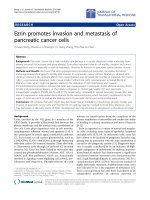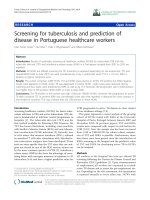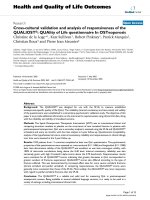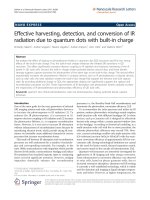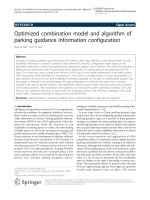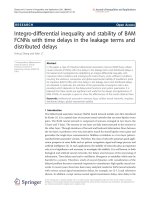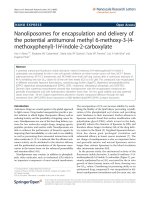báo cáo hóa học:" The reliability, validity and responsiveness of the Dutch version of the Oxford elbow score" pdf
Bạn đang xem bản rút gọn của tài liệu. Xem và tải ngay bản đầy đủ của tài liệu tại đây (290.73 KB, 6 trang )
RESEARCH ARTICLE Open Access
The reliability, validity and responsiveness of the
Dutch version of the Oxford elbow score
Jeroen de Haan
1
, Harold Goei
2
, Niels WL Schep
2
, Wim E Tuinebreijer
2
, Peter Patka
2
and Dennis den Hartog
2*
Abstract
Background: The Oxford elbow score (OES) is an English questionnaire that measures the patients’ subjective
experience of elbow surgery. The OES compr ises three domains: elbow function, pain, and social-psychological
effects. This questionnaire can be completed by the patient and used as an outcome measure after elbow surgery.
The aim of this study was to develop and evaluate the Dutch version of the translated OES for reliability, validity
and responsiveness with respect to patients after elbow trauma and surgery.
Methods: The 12 items of the English-language OES were translated into Dutch and then back-translated; the
back-translated questionnaire was then compared to the original English version. The OES Dutch version was
completed by 69 patients (group A), 60 of whom had an elbow luxation, four an elbow fracture and five an
epicondylitis. QuickDASH, the visual analogue pain scale (VAS) and the Mayo Elbow Performance Index (MEPI) were
also completed to examine the convergent validity of the OES in group A. To calculate the test-retest reliability
and responsiveness of the OES, this questionnaire was completed three times by 43 different patients (group B).
An average of 52 days elapsed between therapy and the administration of the third OES (SD = 24.1).
Results: The Cronbach’s a coefficients for the function, pain and social-psychological domains were 0.90, 0.87 and
0.90, respectively. The intra-class correlation coefficients for the domains were 0.87 for function, 0.89 for pain and
0.87 for social-psychological. The standardised response means for the domains were 0.69, 0.46 and 0.60,
respectively, and the minimal detectable changes were 27.6, 21.7 and 24.0, respectively. The convergent validity for
the function, pain and social-psychological domains, which were measured as the Spearman’s correlation of the
OES domains with the MEPI, were 0.68, 0.77 and 0.77, respectively. The Spearman’s correlations of the OES domains
with QuickDASH were -0.43, -0.44 and -0.47, respectively, and the Spearman’s correlations with the VAS were -0.33,
-0.38 and -0.42, respectively.
Conclusions: The Dutch OES is a reliable and valid 12-item questionnaire that can be completed within several
minutes by patients with elbow injuries. This Dutch questionnaire was useful as an outcome measure in patients
with elbow trauma.
Introduction
Patient-reported outcome measures (PROMS) quantify
the patients’ or populations’ subjective experience in
relation to a healt h condition and its therapy [1]. It is
important to measure quality of life f or several reasons
[2]. A patient’ s self-assessment of their own quality of
life may differ from the judgement of the medical sta ff,
especially with symptoms such as pain. PROMS can
reveal this difference of judgement in routine clinical
practice. In addition , PROMS ca n be used in research
studies to compare two different treatments. Quality of
life measures can be categorised as generic or specific
for diseases or conditions [1]. The Oxford elbow score
(OES) is a specific questionnaire that measures the qual-
ity of life of patients with disorders of the elbow joint
[3]. The OES was designed to measure the outcomes of
elbow surgery from the patient’s perspective. The OES
is a 12-item, patient-reported questionnaire, which
makes it an important outcome measure that is inde-
pendent of the evaluation of the medical team. In the
Netherlands, the QuickDASH questionnaire (Disability
of the Arm, Shoulder and Hand Questionnaire ) is us ed
* Correspondence:
2
Department of Surgery-Traumatology, Erasmus MC, University Medical
Center Rotterdam, P.O. Box 2040, 3000 CA Rotterdam, The Netherlands
Full list of author information is available at the end of the article
de Haan et al. Journal of Orthopaedic Surgery and Research 2011, 6:39
/>© 2011 de Haan et al; licensee BioMed Central Ltd. This is an Op en Access article distributed under the terms of th e Creative Commons
Attribution License ( which permits unrestricted use, distribution, and reprod uction in
any medium, provide d the original work is properly cited.
to measure the state of the upper extremities before and
after therapy [4]. The 11-item QuickDASH question-
naire is a shortened version of the 30-item DASH ques-
tionnaire, which was designed to measure physical
function and symptoms in patients with musculoskeletal
disorders of the upper limbs. Both D ASH and Quick-
DASH have two four-item optional modules, one related
to performing sports and/or playing a musical instru-
ment and one related to work. The test-retest reliability
of QuickDASH in a study of 101 patients was 0. 90 [5].
The DASH questionnaire has been examined for relia-
bility and validity in a group of 50 Dutch patients [6],
andinthatstudy,theCronbach’s alpha coefficient was
0.95, and the test-retest reliability, calculated as the
Pearson’s correlation, was 0.98, although this is not a
test of agreement. This questionnaire, however, was not
specifically developed to assess the elbow region [7].
The QuickDASH questionnaire also differs from the
OES because it only asks patients about their experi-
ences during the preceding week, whereas the OES asks
patients about the preceding four weeks. The OES
includes three domains: an e lbow function domain, a
pain domain (severity and time of day when the pain
occurs) and a social-psychological co ndition domain;
each domain is assessed using four questions. The
answers are recorded on a five-point Likert scale. Every
domain score is calculated to a final score that ranges
from 0 (worst) to 100 (best) [3]. In a study of 104
patients who had undergone a combined total of 107
elbow operations for osteoarthritis, rheumatoid arthritis,
post-traumatic stiffness and epico ndylitis, the OES was
found to be both reliable and valid [3]. In another study,
this questionnaire was found to have a good responsive-
ness or ability to detect changes six months post-surgery
[8]. The difference in the patients’ scores before versus
after elbow surgery was higher with the OES than with
the DASH questionnaire.
The aim of the present study was to develop and eval-
uate the reliability, validity and responsiveness of the
Dutch language version of the OES.
Patients and Me thods
The 12 items of the OES were translated into Dutch
according to the gener ally accepted rules for t ranslation
of non-Dutch questionnaires [9-11]
1
.TheOESwas
translated into Dutch by four clin icians involved in
orthopaedic trauma surgery. One clinician was an epide-
miologist with experience in clinimetrics. The four
translated versions were compared, and the differences
were resolved by discussion. The Dutch version of the
OES was then back-translated to English by a certified
English translator (and native English speaker). The four
clinicians compared this back-translation with the origi-
nal English version of the OES, and they edited the
Dutch translation to make it more accurate. After the
translation process, mistakes w ere encountered in the
tense of the Dutch version of questions seven an d eight,
which referred to pain during the past four weeks.
These mistakes were found after the back-translation
and were corrected.
The OES was validated by calculating the Spearman’s
rank correlation with QuickDASH, the Mayo Elbow Per-
formance Index (MEPI) [12] and the visual analogue
scale for pain (VAS) [13]. The MEPI is one of the most
widely used physician-rated classification systems for
elbow function and its relation to the overall quality of
life [14]. This index consists of four parts: pain, ulno-
humeral motion, stability and the ability to perform five
functional tasks [12]. The MEPI was chosen for valida-
tion because it is an objective, physician- rated question-
naire that is available in the Netherlands. The pain level
was determined with a 10-point VAS, in which zero
implied no pain and ten implied the worst possible pain.
The VAS was chosen because it provides a simple way
to record subjective estimates of pain intensity, and the
fact that pain has a large influence on questionnaires
that assess elbow function [15].
To validate the Dutch OES, the present study exam-
ined a cohort of 69 patients (group A) who were seen
for elbow trauma at f our clinical sites. Patients 15 years
of age or older with a simple or complex elbow disloca-
tion (n = 60), epicondylitis (n = 5) or fracture in the
elbow region ( n = 4) were included from four hospitals
(three rural teaching hospitals and one university hospi-
tal). The patients with previous elbow dislocations were
in a chronic stage with a mean follow-up of 3.3 years,
and the other nine cases were in an acute stage. Patients
younger than 15 years and patients unable to read
Dutch were excluded from the study. The elbow disloca-
tions were treated either with plaster or with a sling for
two weeks. The elbow fractures were reduced a nd
internally fixated. The patients with epicondylitis were
injected locally with platelet-rich plasma. Sixty-nine
patients completed the OES and QuickDASH, and 58
patients completed the VAS for pain.
The MEPI was completed by the physician for 49
patients, and four domains were assessed: pain (maxi-
mum score of 45 points), ulno humeral movement (max-
imum score of 20 points), stability (maximum score of
10 points) and the patient’s ability to accomplish five
functional tasks (maximu m score of 25 points). The fiv e
functional tasks were 1) the ability to comb one’shair,
2) the abili ty to feed oneself, 3) the ability to perform
personal hygiene tasks, 4) the ability to put on a shirt
and 5) the ability to put on one’s shoes.
The patient’s pain level was assessed with the follow-
ing question, “ How much pain do you have in your
elbow?” This question was scored using a 10-point VAS
de Haan et al. Journal of Orthopaedic Surgery and Research 2011, 6:39
/>Page 2 of 6
for pain, with 0 indicating no pain and 10 indicating the
worst possible pain imaginable.
QuickDASH is a st andardised and validated question-
naire that assesses a patient’s symptoms and disabilities
at work and during leisure activities [4]; the QuickDASH
questionnaire can be downlo aded free of charge from
the following website: . This
questionnaire, which assesses the entire upper extremity,
was completed by the patients themselves. The Quick-
DASH questionnaire consists of three modules. The first
module includes 11 questions about symptoms and the
ability to perform certain activities. The second and
third modules, which are both optional, contain four
questions each. The first optional module asks questions
about how the patient is affected at work, and the other
module asks questions about how they are affected
while playing sports or a musical instrument. All of the
questions are scored on a five-point scale. The total
score of each of the three modules is summed and cor-
responds to an overall score on a scale of 0 (no disabil-
ities) to 100 (severe disabilities). All three of the
modules were used for the present analysis. Lastly, the
validity of the Dutch OES was measure d by cal culating
the correlation between the Dutch OES, QuickDASH,
the VAS for pain and the MEPI.
In a separate cohort (group B) of 43 patients, the OES
was administered three times. The elbo w disloca tions in
this second group B were either treated with plaster or
withaslingforthreeweeks.Theelbowfractureswere
reduced and internally fixated. After the operation
patients were allowed to exercise. The patients with epi-
condylitis were injected locally with platelet-rich plasma.
The timing of the administration of the second OES dif-
fered between patients and was performed after a med-
ian time-period of one day (interquartile range = 6.0).
The second test allowed us to calculate the test-retest
reliability.
The OES test was also administered a third time to
the patients of group B; this third administration
allowed us to analyse the ability of the OES to detect
changes in patient status (i.e., to determine its respon-
siveness). An average of 52 days elapsed between ther-
apy and the administration of the third OES (SD = 24.1,
minimum 28 days, maximum 103 days), as clinically
detectable changes were expected after the treatment of
the elbow fractures and dislocations. The firs t adminis-
tration of the OES in group B was performed during the
acute stage of the disorder, with a mean of 16.6 days
(SD = 22.6, minimum -7 days, maximu m 86 days) after
the therapy to increase the possibility of observing a
change between the first administration and third
administration of the OES. The OES refers to the period
of “ the past 4 weeks” , and the interval between the
trauma and the administration of the OES reduced the
possibility of problems for those patients with an acute
trauma to complete the questionnaire.
Statistical Analyses
The questionnaires were imported into the PASW Sta-
tistics 18.0 software package and analysed using the
same computer program. The test reliability was ana-
lysed by calculating the Cronbach’s a coefficient and the
intra-class correlation coefficient (ICC). As a measure of
test-retest agreement for each domain, the stan dard
error of measurement was calculated by dividing the
mean difference in score between the initial test and the
retest by the square root of two [16]. Using the standard
error of measurement, the minimal detectable changes
(MDC) of the three domains were calculated using the
following formula: MDC = 1.96*√2*standard error of
measurement [16]. The standard error of mea surement
and MDC were both expressed on the same scale of
measurement as the OES (i.e., 0-100).
The convergent validity was estimate d by calculating
the Spearman’s correlation coeffi cients among the OES
scores and those for QuickDASH, the VAS for pain and
the MEPI. Spearman’s correlation coefficients were used
because the data of the questionnaires were not nor-
mally distributed.
The ability of the OES to detect changes in patient
status (i.e., responsiveness or longitudinal validity) was
calculated by determining the effect size and the stan-
dardised response means. The effect size was calculated
by dividing the difference in patients’ scores between
the first administration and third administration of the
OES by the standard deviation of the score from the
first administration. The mean standardised response
was calculated by dividing the mean change in score by
the standard deviation of the change in scores.
The percentages of scores be low 25 and above 75 for
the three domains of the OES were calculated to assess
floor and ceiling effects.
Results
The patient characteristics are presented in Table 1. The
mean age of the patients in group A was 43.4 (SD =
14.8) years and 50.9 (SD = 12.8) years in group B. In
group A, 52 of the total patients (75%) were female,
whereas in group B, 27 patients (63%) were female.
The outcomes of the OES analysis are shown in Table
2. By removing the qu estion “How would you describe
the pain you usually had from your elbow?” from the
pain domain, Cronbach’s a coefficient of this domain
increased slightly to 0.90. Removal of any other ques-
tions decreased the Cronbach’ s a coefficient for the
respective domain. When a single question from the
functiondomain,eitherquestion1,2,3or4,was
removed from the analysis, the Cronbach’s a coefficients
de Haan et al. Journal of Orthopaedic Surgery and Research 2011, 6:39
/>Page 3 of 6
were 0.87, 0.87, 0.88 or 0.87, respectively. When either
question 7, 8, 11 or 12 (from the pain domain) was
removed from the analysis, the Cronbach’s a coefficients
were 0.78, 0.79, 0.86 or 0.90, respectively; the Cron-
bach’s a coefficients were 0.88, 0.87, 0.85 or 0.89, when
question 5, 6, 9 or 10 (from the social-psychological
domain), respectively, was removed from the analysis.
The Spearman correlation coefficients among the
three domains of the OES and QuickDASH, the VAS for
pain, and the MEPI (which were calculated to evaluate
the convergent validity of t he OES among the patients
in group A) are shown in Table 3.
Discussion
In the present study, the reliability (expressed as Cron-
bach’s a coefficient for internal consistency) and t he
test-retest reliability of the Dutch version of the OES
were both high for all three of the domains. In a study
by Dawson et al., the Cronbach’s a coefficients for the
three domains were also found to be high: for the elbow
function domain, it was 0.90; for the pain domain, it
was 0.89; and for the social-psychological domain, it was
0.84; the ICC value s for each domain in this study were
0.89, 0.98 and 0.87, respectively [3].
The effect sizes and standardised response means,
whichareameasureofthetest’ s responsiveness or its
ability to detect changes in patients’ conditions, were
moderate. This finding was in cont rast to the study o f
Dawson et al., which found that the English OES
domains had large effect sizes (i.e., 0.79, 1.14 and 1.18
for the function, pain and social-psychological domains,
respectively) [8]. This difference in effect sizes and stan-
dardised response means can be explained by our
shorter period of follow-up at the third administration
of the OES. Except for pain, the standard error of m ea-
surement and the MDC m easurements of the three
domains were comparable to those in the Dawson et al.
study [8]. The standard error of measurements for the
function, pain a nd social-psychological domains in the
Dawson et al. study were reported to be 8.23, 3.58 and
8.51, respectively, and the MDCs were 18.73, 8.25 and
18.85, respectively [8]. The difference in the standard
error of measurement a nd MDC for pain can be
explained b y the different time period between the first
administration and second administratio n of the OES in
our study (interquartile range = 6.0 days) and the study
of Dawson et al. (an interval of 2 days for all of the
patients) [3,8]. Terwee et al. also found a large variation
in the values of minimal important change of PROMS
by the same method across studies and across different
methods within studies [17]. The authors stated that
caution was needed when interpreting and using pub-
lished minimal important change values.
The distribution of the domain scores showed that a
high percentage of patients had superior scores a bove
75. This finding could point to a ceiling effect of the
OES, which is a failure to detect differences between
patients with a high score; differences at the high end of
the scale could be too small to reliably distinguish indi-
viduals. But it is usual to obtain skewed scores in oppo-
site directions for pre and postsurgical i nterventions in
orthopaedics and ceiling effects are more relevant to
item level rather than to the overall score analysis.
Table 1 Patient characteristics.
Characteristics Group A Group B
N 69 43
Gender (N)
female 52 27
male 17 16
Age (years) 43.4 (SD = 14.8) 50.9 (SD = 12.8)
Diagnosis (N)
elbow dislocation 60 19
elbow fracture 414
epicondylitis 55
arthrolysis 2
other elbow conditions 3
Table 2 Results of the analysis of the OES.
OES domains
Function Pain Social-psychological
Mean score (SD) pre-intervention data 66.7 (28.8) 69.2 (27.5) 62.5 (30.2)
Cronbach’s a pre-intervention data 0.90 0.87 0.90
Intra-class correlation coefficient (95% CI) 0.87 (0.75, 0.93) 0.89 (0.78, 0.94) 0.87 (0.73, 0.93)
Standard error of measurement 9.9 7.8 8.7
Minimal detectable change 27.6 21.7 24.0
Effect size .56 .49 .54
Standardised response mean .69 .46 .60
% scores < 25 pre-intervention data 16.2 11.1 19.2
% scores > 75 pre-intervention data 42.5 47.6 38.4
CI = confidence interval
de Haan et al. Journal of Orthopaedic Surgery and Research 2011, 6:39
/>Page 4 of 6
The correlation between the three domains of the
Dutch version of the OES and the MEPI was high,
which indicates that the OES has a good convergent
validity. The MEPI score was mainly determined b y the
contribution of elbow pain (45%) to the patients’ overall
elbow functioning. Doornberg et al. have concluded that
pain has a large influence on questionnaires that assess
elbow function, both those that are completed by physi-
cians and those that are completed by the patient s [15];
however, it should be noted that Doornberg et al. did
not examine the OES in their study. In our study, the
correl ation between the OES and the QuickDASH ques-
tionnaire was moderate. Dawson et al., however, have
found a high degree of correlation between the 30-it em
DASH and the function domain of the OES (-0 .84) but
only a moderate degree of correlation between the
DASH and the pain (-0.66) and social-psychological
domains (-0.59) [3]. Interestingly, in a continuation
study that was performed in a different patient popula-
tion, Dawson et al. found a mo derate correlation
between the OES and the 30-item DASH (-0.51, -0.54
and -0.58 for the function, pain and social-psychological
domains, respectively), which was more in accordance
with our findings [8]. The moderate correlation between
the OES and QuickDASH can be a ttributed to the dif-
ference in time recall because the QuickDASH question-
naire asks patients about the preceding week, and the
OES addresses the past four weeks. The VAS for pain
had a moderate correlation with the O ES, which was
probably because the OES assesses a patient’ spain
under specific circumstances, such as during the night.
In contrast, the VAS for pain assesses a patient’smean
overall pain intensity at the pre sent moment and does
not ask if the degree of pain changes under specific
circumstances.
This study had several limitations, including the small
sample sizes and a homogeneous patient population (i.
e., patients with elbow trauma) in the two studied
cohorts. The reliability of a measuring instrument in
classical test theory is characteristic of the sample
tested. Another limitation of this study was the variation
in the time that elapsed between the first administration
and second administration of the OES as well as
between the first administration and third administra-
tion. The OES refe rs to the preceding four weeks, and,
during this period, the patients were treated for their
elbow dislocation with a plaster or sling, which could
have interfered with their movements that were
addressed by the questions of the OES. This problem
could have affected the correlations with the other
instruments which used different periods of recall. The
variability in time between the administrations could
have lowered the ICCs of the OES domains. In addition,
the variability in the length of time between the OES
administrations could have influenced the standard
error of the measurements, the MDC and the effect size
measures.
Because our patient population included a relatively
homogeneous group, future studies should examine
OES results in patients with other types of elbow disor-
ders. An analysis of the OES via modern test theory
would also be necessary to examine the ordering of the
five scoring categories.
Conclusion
The Dutch OES is a reliable and val id 12-item question-
naire that c an be completed within several minutes by
patients with elbow injuries. This Dutch questionnaire
was useful as an outcome measure in patients with
elbow trauma, and the Dutch language version can now
be applied in the Dutch population.
Future studies will use this Dutch OES in a rando-
mised controlled trial for the evaluation of the func-
tional treatment of simple elbow dislocations [18]. In
addition, the Dutch OES will be used in an observa-
tional study of surgeries of complex elbow dislocations.
Specified notice
Oxford Elbow Score
©
Isis Innovation Limi ted, 2008. All
rights reserved.
The authors, being Professor Ray Fitzpatrick and Dr.
Jill Dawson, have asserted their moral rights.
Acknowledgements
The Oxford and Isis Outcomes, part of Isis Innovation Limited, are
acknowledged for their kind support.
Table 3 Correlation between the three domains of the Oxford elbow score, the QuickDASH domains, the visual
analogue pain scale (VAS), and the Mayo elbow performance index (MEPI).
Oxford elbow score domain Function
N=69
Pain
N=69
QuickDASH total
N=69
QuickDASH
work
N=53
QuickDASH sports/music
N=48
VAS pain
N=58
MEPI
N=49
Function 43** 23 35* 33* .68**
Pain .85** 44** 32* 42** 38** .77**
Social-psychological condition .84** .89** 47** 38** 46** 42** .77**
**p < 0.01 and *p < 0.05. Spearman’s correlation coefficients were calculated to assess the relationship between the results of each OES domain and the
questionnaires listed above.
de Haan et al. Journal of Orthopaedic Surgery and Research 2011, 6:39
/>Page 5 of 6
1
Footnote Permission for the translation and the use of the OES for two
studies was obtained from Oxford and Isis Outcomes, which is part of Isis
Innovation Limited (website: />Author details
1
Department of Surgery-Traumatology, Westfriesgasthuis, P.O. Box 600, 1620
AR Hoorn, The Netherlands.
2
Department of Surgery-Traumatology, Erasmus
MC, University Medical Center Rotterdam, P.O. Box 2040, 3000 CA Rotterdam,
The Netherlands.
Authors’ contributions
JDH, NWLS, HG, WET and DDH developed the study and drafted and revised
the manuscript. WET performed the statistical analysis of the data. JDH, DDH
and HG participated in patient inclusion and assessment. All of the authors
have read and approved the final manuscript.
Competing interests
The authors declare that they have no competing interests.
Received: 7 December 2010 Accepted: 30 July 2011
Published: 30 July 2011
References
1. Patrick D, Guyatt GH, Acquadro C: Patient-reported outcomes. In Cochrane
Handbook for Systematic Reviews of Interventions. Edited by: Higgens JPT,
Green S. Chichester (UK): John Wiley 2008:531-545.
2. Walters SJ: Quality of Life Outcomes in Clinical Trials and Health-Care
Evaluation: A Pratical Guide to Analysis and Interpretation. Chichester
(UK): John Wiley & Sons, Ltd; 2009.
3. Dawson J, Doll H, Boller I, Fitzpatrick R, Little C, Rees J, Jenkinson C, Carr AJ:
The development and validation of a patient-reported questionnaire to
assess outcomes of elbow surgery. J Bone Joint Surg Br 2008,
90(4):466-473.
4. Beaton DE, Wright JG, Katz JN: Development of the QuickDASH:
comparison of three item- reduction approaches. J Bone Joint Surg Am
2005, 87(5):1038-1046.
5. Mintken PE, Glynn P, Cleland JA: Psychometric properties of the
shortened disabilities of the Arm, Shoulder, and Hand Questionnaire
(QuickDASH) and Numeric Pain Rating Scale in patients with shoulder
pain. J Shoulder Elbow Surg 2009, 18(6):920-926.
6. Veehof MM, Sleegers EJ, van Veldhoven NH, Schuurman AH, van
Meeteren NL: Psychometricqualities of the Dutch language version of
the Disabilities of the Arm, Shoulder, and Hand questionnaire (DASH-
DLV). J Hand Ther 2002, 15(4):347-354.
7. Hudak PL, Amadio PC, Bombardier C: Development of an upper extremity
outcome measure: the DASH (disabilities of the arm, shoulder and
hand) [corrected]. The Upper Extremity Collaborative Group (UECG). Am
J Ind Med 1996, 29:602-608.
8. Dawson J, Doll H, Boller I, Fitzpatrick R, Little C, Rees J, Carr A: Comparative
responsiveness and minimal change for the Oxford Elbow Score
following surgery. Qual Life Res 2008, 17(10):1257-1267.
9. Beaton DE, Bombardier C, Guillemin F, Ferraz MB: Guidelines for the
process of cross- ultural adaptation of self-report measures. Spine 2000,
25(24):3186-3191.
10. Floor S, Overbeke AJ: [Questionnaires on the quality of life in other than
the Dutch language used in the Nederlands Tijdschrift voor
Geneeskunde (Dutch Journal of Medicine): the translation procedure
and arguments for the choice of the questionnaire]. Ned Tijdschr
Geneeskd 2006, 150:1724-1727.
11. Guillemin F, Bombardier C, Beaton D: Cross-cultural adaptation of health-
related quality of life measures: literature review and proposed
guidelines. J Clin Epidemiol 1993, 46(12):1417-1432.
12. Morrey BF, Adams RA: Semiconstrained arthroplasty for the treatment of
rheumatoid arthritis of the elbow. J Bone Joint Surg Am 1992,
74(4):479-490.
13. McDowell I: Pain Measurements. Measuring health. A guide to rating scales
and questionnaires Oxford: Oxford University Press; 2006, 470-519.
14. Longo UG, Franceschi F, Loppini M, Maffulli N, Denaro V: Rating systems
for evaluation of the elbow. Br Med Bull 2008, 87:131-161.
15. Doornberg JN, Ring D, Fabian LM, Malhotra L, Zurakowski D, Jupiter JB:
Pain dominates measurements of elbow function and health status. J
Bone Joint Surg Am
2005, 87(8):1725-1731.
16. de Vet HC, Terwee CB, Knol DL, Bouter LM: When to use agreement
versus reliability measures. J Clin Epidemiol 2006, 59(10):1033-1039.
17. Terwee CB, Roorda LD, Dekker J, Bierma-Zeinstra SM, Peat G, Jordan KP,
Croft P, de Vet HCW: Mind the MIC: large variation among populations
and methods. J Clin Epidemiol 2010, 63(5):524-534.
18. de Haan J, den Hartog D, Tuinebreijer WE, Iordens GI, Breederveld RS,
Bronkhorst MW, Bruijninckx MM, De Vries MR, Dwars BJ, Eygendaal D,
Haverlag R, Meylaerts SA, Mulder JW, Ponsen KJ, Roerdink WH,
Roukema GR, Schipper IB, Schouten MA, Sintenie JB, Sivro S, Van den
Brand JG, Van der Meulen HG, Van Thiel TP, van Vugt AB, Verleisdonk EJ,
Vroemen JP, Waleboer M, Willems WJ, Polinder S, Patka P, van Lieshout EM,
Schep NW: Functional treatment versus plaster for simple elbow
dislocations (FuncSiE): a randomized trial. BMC Musculoskelet Disord 2010,
11(1):263.
doi:10.1186/1749-799X-6-39
Cite this article as: de Haan et al.: The reliability, validity and
responsiveness of the Dutch version of the Oxford elbow score. Journal
of Orthopaedic Surgery and Research 2011 6:39.
Submit your next manuscript to BioMed Central
and take full advantage of:
• Convenient online submission
• Thorough peer review
• No space constraints or color figure charges
• Immediate publication on acceptance
• Inclusion in PubMed, CAS, Scopus and Google Scholar
• Research which is freely available for redistribution
Submit your manuscript at
www.biomedcentral.com/submit
de Haan et al. Journal of Orthopaedic Surgery and Research 2011, 6:39
/>Page 6 of 6
